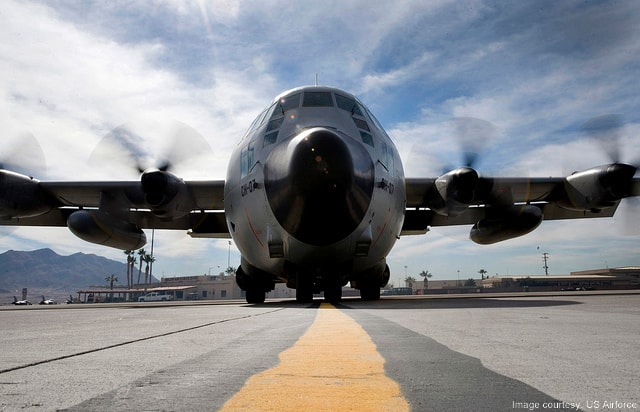The C-130 Hercules, named after the mythical Greek hero, is the US Air Force’s principal tactical cargo and personnel transport aircraft. The C-130 has fulfilled a wide range of both peaceful and war situations since its initial production in 1954. The original C-130, and variations of the aircraft since then, have performed a wide range of duties, including airlift support, aerial spray missions, firefighting, natural disaster relief and aeromedical missions.

According to the U.S. Air Force, the C-130 can accommodate a variety of oversized cargo, including utility helicopters, armored vehicles, palletized cargo and military personnel. The Hercules C-130, having served in over 60 countries, can airdrop loads up to 42,000 pounds from its loading ramp and door. The C-130 can provide rapid transport for delivery by parachute over a designated drop zone, or by landing the aircraft in most any conditions. The C-130 also has the capability of landing on land or sea.
The improvements that have been built into the original aircraft, now called C-130J, are impressive. The C-130J features state-of-the-art technology that both reduces manpower requirements and lowers operating and support costs. The J Model has a decreased climb time, extensively integrated defensive systems, digital moving map display, low-power color radar, new turboprop engines with six-bladed all-composite propellers and a digital auto pilot.
The Centerline Vertical Restraint System (CVRS) developed by Capewell, is designed for any C-130 aircraft to provide vertical and lateral restraint of Container Delivery System (CDS) containers during flight and throughout the airdrop phase. The CVRS permits the airdrop of up to twelve A-22 containers from each side of the aircraft. Each container can be rigged and airdropped in a single pass, for a total of 24 individual containers, or all twenty-four can be airdropped simultaneously. The CVRS was designed to accommodate 48-inch plywood skidboards; however, 48-inch by 53.5-inch and 48-inch by 96-inch plywood skidboards may be airdropped with the cvrs installed by rotating the skidboard(s) 90 degrees to allow the 48-inch side to fit between the CVRS and the aircraft dual rails. The CVRS uses the existing tiedown rings in the aircraft and provides a similar set of tiedown rings as a replacement. No special tools are required to install the CVRS and two personnel can install or remove CVRS in less than 30 minutes.

